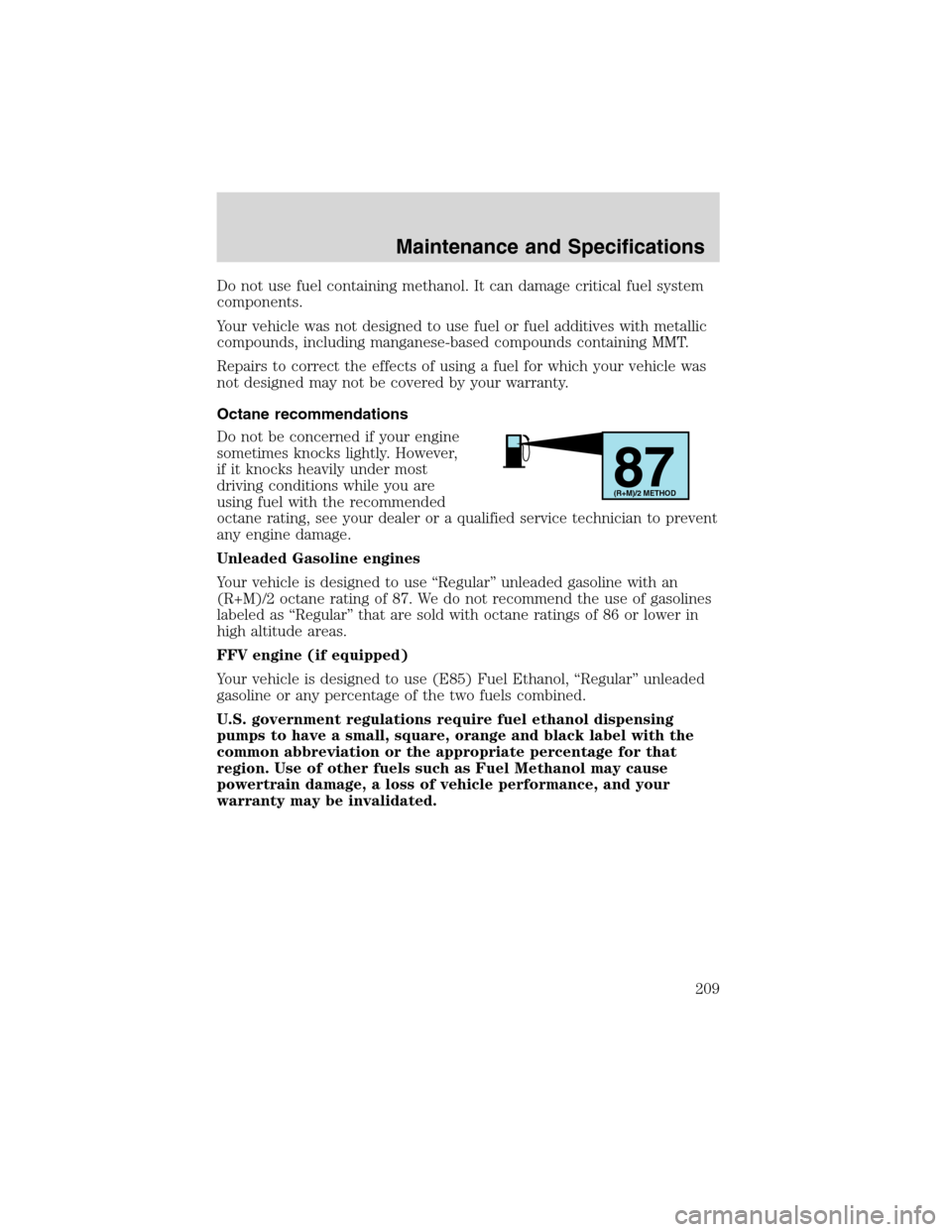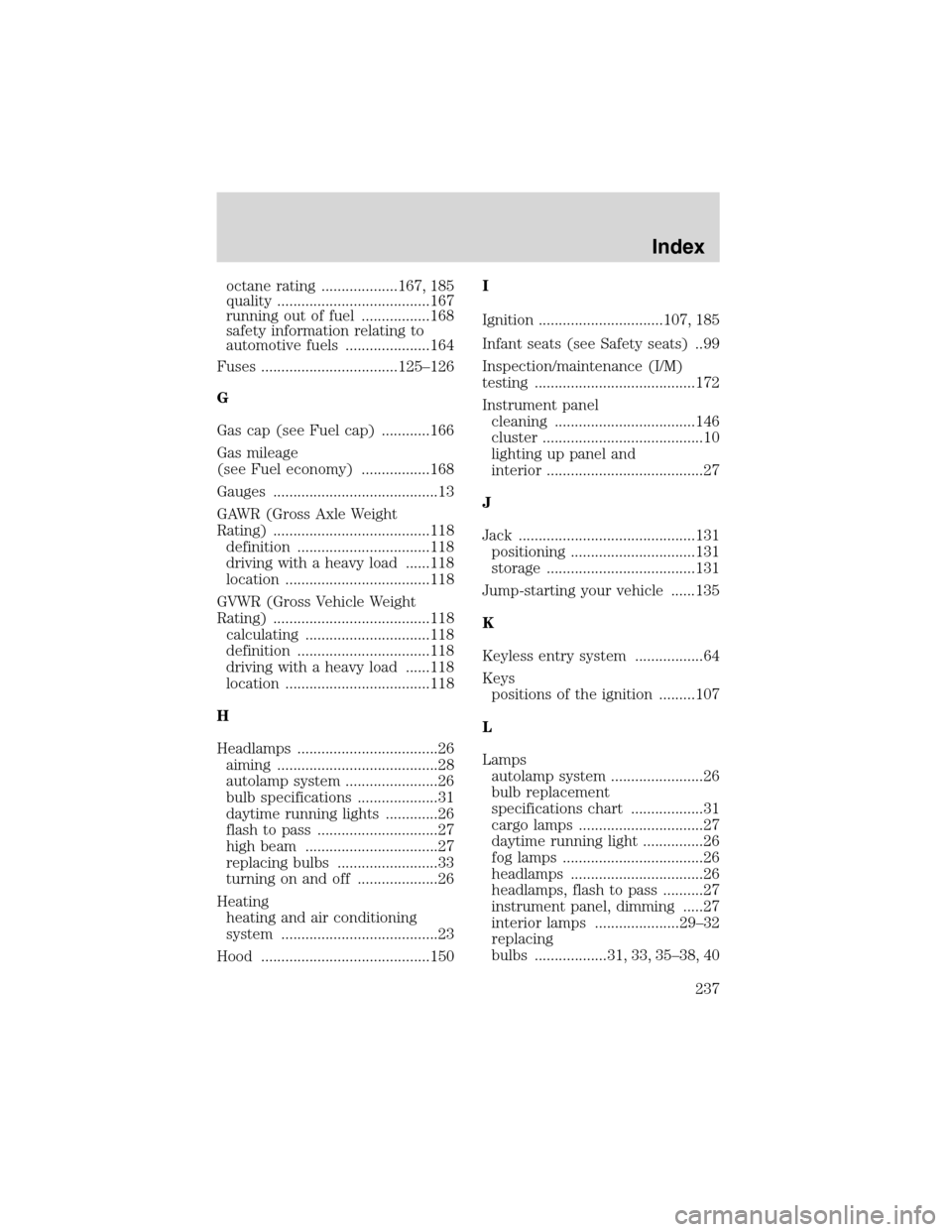air condition Mercury Sable 2002 s Owner's Guide
[x] Cancel search | Manufacturer: MERCURY, Model Year: 2002, Model line: Sable, Model: Mercury Sable 2002Pages: 240, PDF Size: 3.53 MB
Page 209 of 240

Do not use fuel containing methanol. It can damage critical fuel system
components.
Your vehicle was not designed to use fuel or fuel additives with metallic
compounds, including manganese-based compounds containing MMT.
Repairs to correct the effects of using a fuel for which your vehicle was
not designed may not be covered by your warranty.
Octane recommendations
Do not be concerned if your engine
sometimes knocks lightly. However,
if it knocks heavily under most
driving conditions while you are
using fuel with the recommended
octane rating, see your dealer or a qualified service technician to prevent
any engine damage.
Unleaded Gasoline engines
Your vehicle is designed to use“Regular”unleaded gasoline with an
(R+M)/2 octane rating of 87. We do not recommend the use of gasolines
labeled as“Regular”that are sold with octane ratings of 86 or lower in
high altitude areas.
FFV engine (if equipped)
Your vehicle is designed to use (E85) Fuel Ethanol,“Regular”unleaded
gasoline or any percentage of the two fuels combined.
U.S. government regulations require fuel ethanol dispensing
pumps to have a small, square, orange and black label with the
common abbreviation or the appropriate percentage for that
region. Use of other fuels such as Fuel Methanol may cause
powertrain damage, a loss of vehicle performance, and your
warranty may be invalidated.
87(R+M)/2 METHOD
Maintenance and Specifications
209
Page 213 of 240

economy under current driving conditions. Additionally, keeping records
during summer and winter will show how temperature impacts fuel
economy. In general, lower temperatures give lower fuel economy.
Driving style—good driving and fuel economy habits
Give consideration to the lists that follow and you may be able to change
a number of variables and improve your fuel economy.
Habits
•Smooth, moderate operation can yield up to 10% savings in fuel.
•Steady speeds without stopping will usually give the best fuel
economy.
•Idling for long periods of time (greater than one minute) may waste
fuel.
•Anticipate stopping; slowing down may eliminate the need to stop.
•Sudden or hard accelerations may reduce fuel economy.
•Slow down gradually.
•Driving at reasonable speeds (traveling at 88 km/h [55 mph] uses 15%
less fuel than traveling at 105 km/h [65 mph]).
•Revving the engine before turning it off may reduce fuel economy.
•Using the air conditioner or defroster may reduce fuel economy.
•You may want to turn off the speed control in hilly terrain if
unnecessary shifting between third and fourth gear occurs.
Unnecessary shifting of this type could result in reduced fuel
economy.
•Warming up a vehicle on cold mornings is not required and may
reduce fuel economy.
•Resting your foot on the brake pedal while driving may reduce fuel
economy.
•Combine errands and minimize stop-and-go driving.
Maintenance
•Keep tires properly inflated and use only recommended size.
•Operating a vehicle with the wheels out of alignment will reduce fuel
economy.
•Use recommended engine oil. Refer toLubricant specificationsin
this chapter.
Maintenance and Specifications
213
Page 237 of 240

octane rating ...................167, 185
quality ......................................167
running out of fuel .................168
safety information relating to
automotive fuels .....................164
Fuses ..................................125–126
G
Gas cap (see Fuel cap) ............166
Gas mileage
(see Fuel economy) .................168
Gauges .........................................13
GAWR (Gross Axle Weight
Rating) .......................................118
definition .................................118
driving with a heavy load ......118
location ....................................118
GVWR (Gross Vehicle Weight
Rating) .......................................118
calculating ...............................118
definition .................................118
driving with a heavy load ......118
location ....................................118
H
Headlamps ...................................26
aiming ........................................28
autolamp system .......................26
bulb specifications ....................31
daytime running lights .............26
flash to pass ..............................27
high beam .................................27
replacing bulbs .........................33
turning on and off ....................26
Heating
heating and air conditioning
system .......................................23
Hood ..........................................150I
Ignition ...............................107, 185
Infant seats (see Safety seats) ..99
Inspection/maintenance (I/M)
testing ........................................172
Instrument panel
cleaning ...................................146
cluster ........................................10
lighting up panel and
interior .......................................27
J
Jack ............................................131
positioning ...............................131
storage .....................................131
Jump-starting your vehicle ......135
K
Keyless entry system .................64
Keys
positions of the ignition .........107
L
Lamps
autolamp system .......................26
bulb replacement
specifications chart ..................31
cargo lamps ...............................27
daytime running light ...............26
fog lamps ...................................26
headlamps .................................26
headlamps, flash to pass ..........27
instrument panel, dimming .....27
interior lamps .....................29–32
replacing
bulbs ..................31, 33, 35–38, 40
Index
237